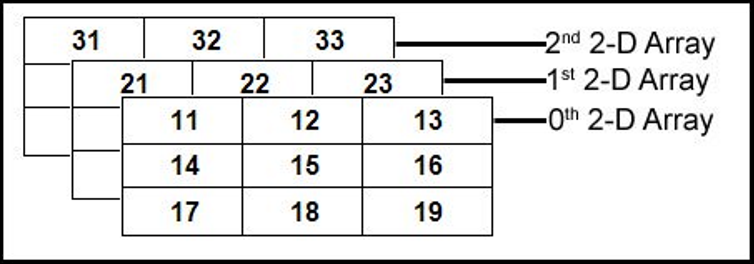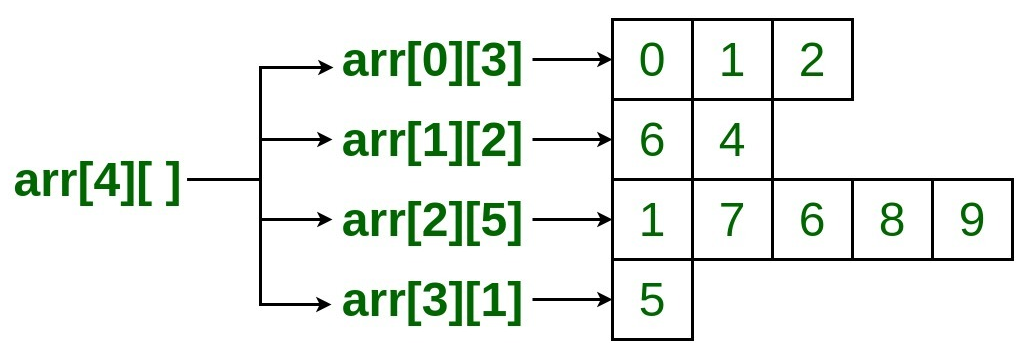Arrays
- One variable for homogeneous collection.
- Stored in Contiguous memory locations.
- Allow random access.
- have better cache locality, improving performance.
- Good for static size list otherwise double it and copy(overhead).
DS to store homogeneous elements at contiguous locations. Size to be provided before storing data.
- Accessing Time: O(1) [This is possible because elements are stored at contiguous locations]
- Search Time : O(n) for Sequential Search: O(log n) for Binary Search [If Array is sorted]
- Insertion Time: O(n) [worst case, insertion at Beginning and shifting all of the elements]
- Deletion Time : O(n) [worst case, deletion at Beginning and shifting all of the elements]
| Operations | ||
|---|---|---|
| Access | O(1) | |
| Insert | O(n) | Worst case - array is full, create new array and copy the old array elements. |
| Delete | O(n) | Worst case - deletion at index 0, all elements to be adjusted. |
- Arrays in C gave only warning but no ArrayOutOfBoundException.
- Java arrays are dynamically allocated at runtime “on the fly”.
- arrays have a member variable public final field length which is int and provided at construction time.
- direct superclass of an array type is Object.
- Every array type implements the interfaces Cloneable and java.io.Serializable.
- Storage specification
- A local array will be (usually) created on stack.
- A global or static array will be (usually) created on bss/data segments
- A dynamically created array will be created on heap.
- For primitive data types, the actual values are stored in contiguous memory locations.
- For objects, the actual objects are stored in heap segment.
- Can be Row Major (normally used) or Column Major. I prefer row major, for i -> j.
- Capacity - Max elements that can be stored in array, .length property of array.
ArrayIndexOutOfBoundsExceptionfor invalid index.
- Length - Current number of stored element, you must do a loop and check or keep a track yourself with some variable.
- For Coding Interview, it can be assumed that input arrays passed in methods are completely filled and .length will give capacity (upper bound index).
Practical Uses of Array
- Dynamic Programming
- Creating Hash Tables
1-D Array

MultiDimensional Array
int intArray[]; //declaring array
intArray = new int[20]; // allocating memory to array
// Default values
boolean : false, int : 0, double : 0.0, String : null, User Defined Type : null
//a 2D array or matrix
int[][] intArray = new int[10][20];
//a 3D array
int[][][] intArray = new int[10][20][10];

int arr[][] = { {2,7,9},{3,6,1},{7,4,2} };
int arr[][] = new int[2][];
arr[0] = new int[3];
arr[1] = new int[2];
for (int i=0; i<arr.length; i++)
for(int j=0; j<arr[i].length; j++)
arr[i][j] = count++;
Jagged array
array of arrays such that member arrays can be of different sizes, i.e., we can create a 2-D arrays but with variable number of columns in each row.

Cloning of arrays
- 1D array, “deep copy” is performed.
- 2D array, “shallow copy” creates only a single new array with each element array a reference to an original element array but subarrays are shared.

Arrays as Dynamic List
- no adequate max size
- on array becoming full, insertion needs creation of new array and copy old items.
- contiguous memory of required size may not be available.
Left Rotation
Write a function rotate(ar[], d, n) that rotates arr[] of size n by d elements.
Method 1 (Using temp array)
Input arr[] = [1, 2, 3, 4, 5, 6, 7], d = 2, n =7 1) Store d elements in a temp array: temp[] = [1, 2] 2) Shift rest of the arr[]: arr[] = [3, 4, 5, 6, 7, 6, 7] 3) Store back the d elements: arr[] = [3, 4, 5, 6, 7, 1, 2]
- Time complexity : O(n)
- Auxiliary Space : O(d)
Method 2 (Rotate one by one)
leftRotate(arr[], d, n)
start
For i = 0 to i < d
Left rotate all elements of arr[] by one
end
- Time complexity : O(n * d)
- Auxiliary Space : O(1)
Method 3 (A Juggling Algorithm)
This is an extension of method 2. Instead of moving one by one, divide the array in different sets where number of sets is equal to GCD of n and d and move the elements within sets.
n =12 and d = 3. GCD is 3.
Let arr[] be {1, 2, 3, 4, 5, 6, 7, 8, 9, 10, 11, 12}
- Elements are first moved in first set
- arr[] after this step –> {
42 375 6108 9111 12}
- arr[] after this step –> {
- Then in second set.
- arr[] after this step –> {4
53 786 10119 1212}
- arr[] after this step –> {4
- Finally in third set.
- arr[] after this step –> {4 5
67 8910 11121 23}
- arr[] after this step –> {4 5

- Time complexity: O(n)
- Auxiliary Space: O(1)
My thoughts- Make block of size d rather than GCD of n,d